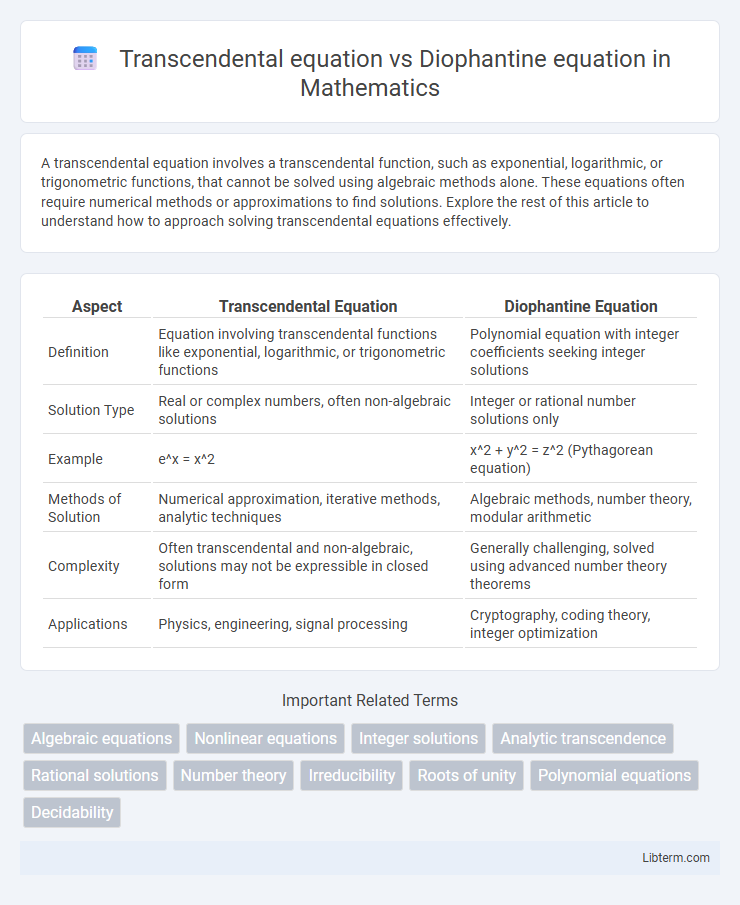A transcendental equation involves a transcendental function, such as exponential, logarithmic, or trigonometric functions, that cannot be solved using algebraic methods alone. These equations often require numerical methods or approximations to find solutions. Explore the rest of this article to understand how to approach solving transcendental equations effectively.
Table of Comparison
| Aspect | Transcendental Equation | Diophantine Equation |
|---|---|---|
| Definition | Equation involving transcendental functions like exponential, logarithmic, or trigonometric functions | Polynomial equation with integer coefficients seeking integer solutions |
| Solution Type | Real or complex numbers, often non-algebraic solutions | Integer or rational number solutions only |
| Example | e^x = x^2 | x^2 + y^2 = z^2 (Pythagorean equation) |
| Methods of Solution | Numerical approximation, iterative methods, analytic techniques | Algebraic methods, number theory, modular arithmetic |
| Complexity | Often transcendental and non-algebraic, solutions may not be expressible in closed form | Generally challenging, solved using advanced number theory theorems |
| Applications | Physics, engineering, signal processing | Cryptography, coding theory, integer optimization |
Introduction to Transcendental and Diophantine Equations
Transcendental equations involve functions such as exponential, logarithmic, or trigonometric functions that are not algebraic, often requiring numerical methods for solutions due to their complexity. Diophantine equations are polynomial equations where only integer solutions are sought, with classical examples including linear, quadratic, and higher-degree equations crucial in number theory. Understanding the fundamental differences in their functional forms and solution sets is essential for leveraging appropriate mathematical techniques in solving these distinct types of equations.
Defining Transcendental Equations
Transcendental equations involve functions that are not algebraic, such as exponential, logarithmic, trigonometric, and inverse trigonometric functions, making them fundamentally different from polynomial equations. These equations cannot be expressed solely with a finite combination of algebraic operations like addition, subtraction, multiplication, division, or root extraction. In contrast, Diophantine equations seek integer solutions to polynomial equations, emphasizing discrete solution sets rather than the often continuous or transcendental nature of solutions to transcendental equations.
Defining Diophantine Equations
Diophantine equations are polynomial equations for which integer solutions are sought, typically involving multiple variables with constraints on integral values. Unlike transcendental equations, which contain transcendental functions such as exponential or trigonometric terms and often require numerical methods for approximation, Diophantine equations focus on exact integer solutions and are central to number theory. Famous examples include Fermat's Last Theorem and Pell's equation, highlighting their deep connections to algebraic structures and integer properties.
Fundamental Differences Between the Two Equation Types
Transcendental equations involve functions such as exponential, logarithmic, or trigonometric expressions that cannot be expressed as finite polynomials, making their solutions often non-algebraic and infinite. Diophantine equations seek integer or rational number solutions to polynomial equations with integer coefficients, emphasizing discrete and exact solutions rather than continuous ranges. The fundamental difference lies in the nature of solutions: transcendental equations require approximation methods for potentially infinite real or complex roots, while Diophantine equations focus on finite sets of integer solutions verified through number theory techniques.
Common Examples of Transcendental Equations
Common examples of transcendental equations include \( e^x = x \), \( \sin x = x/2 \), and \( \ln x = 3x \), each involving transcendental functions such as exponential, trigonometric, and logarithmic functions. Unlike Diophantine equations, which require integer solutions to polynomial equations like \( ax + by = c \), transcendental equations often involve non-algebraic expressions and usually have infinite or complex solution sets. Solving transcendental equations typically requires numerical methods due to their non-polynomial nature, contrasting with the integer-focused approach of Diophantine problem-solving.
Typical Examples of Diophantine Equations
Diophantine equations typically involve polynomial equations where solutions are sought in integers or rational numbers; classic examples include the Pythagorean equation x2 + y2 = z2 and Fermat's Last Theorem equation xn + yn = zn for integer n > 2. Unlike transcendental equations, which contain transcendental functions like exponential or logarithmic functions (e.g., ex = 2), Diophantine equations are strictly algebraic and focus on discrete solutions. The study of Diophantine equations is fundamental in number theory, addressing problems such as the determination of integer solutions and their properties.
Methods of Solving Transcendental Equations
Solving transcendental equations often involves numerical methods such as the Newton-Raphson method, fixed-point iteration, or the bisection method due to the presence of non-algebraic terms like exponential, logarithmic, or trigonometric functions. Unlike Diophantine equations, which seek integer solutions and generally rely on algebraic or number-theoretic techniques, transcendental equations rarely yield closed-form solutions and require approximation algorithms. Computational tools and software packages like MATLAB or Mathematica are commonly used to implement these iterative methods for accurate root-finding in transcendental equations.
Strategies for Solving Diophantine Equations
Diophantine equations require integer solutions and are often solved using methods such as modular arithmetic, the Euclidean algorithm, and the theory of linear combinations. Techniques like bounding values with inequalities, factorization, and the use of continued fractions facilitate finding integer solutions. Exploring properties of the equation through number theory helps reduce complexity and identify possible solution sets efficiently.
Applications in Mathematics and Science
Transcendental equations, involving functions such as exponential, trigonometric, and logarithmic expressions, are crucial in physics for modeling wave behavior, quantum mechanics, and electrical circuits, where exact algebraic solutions rarely exist. Diophantine equations, characterized by integer solutions to polynomial equations, play a foundational role in number theory, cryptography, and coding theory, enabling secure communication and error detection. Both types of equations facilitate problem-solving in pure and applied mathematics, but their applications diverge with transcendental equations addressing continuous phenomena and Diophantine equations tackling discrete structures.
Summary: Choosing the Right Approach
Transcendental equations involve transcendental functions such as exponential, logarithmic, or trigonometric functions, requiring analytical or numerical methods like Newton-Raphson for solutions. Diophantine equations focus on finding integer solutions to polynomial equations, often solved using number theory techniques such as modular arithmetic or the Euclidean algorithm. Selecting the appropriate approach depends on whether the problem demands continuous numerical approximation for transcendental forms or discrete integer solutions for Diophantine cases.
Transcendental equation Infographic

 libterm.com
libterm.com